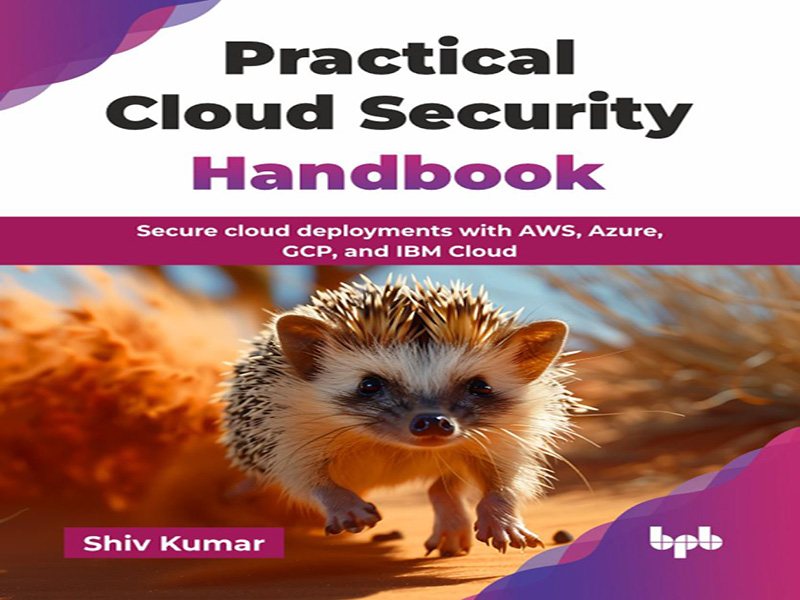- عنوان کتاب: Practical Cloud Security Handbook -Secure cloud deployments with AWS, Azure, GCP, and IBM Cloud
- نویسنده/انتشارات: Shiv Kumar
- حوزه: امنیت ابر
- سال انتشار: 2025
- تعداد صفحه: 363
- زبان اصلی: انگلیسی
- نوع فایل: pdf
- حجم فایل: 4.64 مگابایت
در چشمانداز دیجیتال امروز، رایانش ابری به ستون فقرات زیرساختهای مدرن تبدیل شده است و کسبوکارها را در هر مقیاسی با چابکی، مقیاسپذیری و بهرهوری هزینه بینظیر، توانمند میسازد. با این تغییر عظیم به سمت ابر، اهمیت امنیت ابری قوی و مقیاسپذیر از اهمیت بالایی برخوردار شده است. کتاب راهنمای عملی امنیت ابر، یک راهنمای گام به گام است که برای متخصصان فناوری اطلاعات، معماران، توسعهدهندگان و مهندسان امنیتی طراحی شده است که هدفشان درک و پیادهسازی محیطهای ابری امن در ارائهدهندگان پیشرو خدمات ابری مانند خدمات وب آمازون (AWS)، مایکروسافت آزور، IBM Cloud و پلتفرم ابری گوگل (GCP) است. این کتاب از چالشهای دنیای واقعی که هنگام طراحی و ایمنسازی سیستمهای بومی ابری و ترکیبی در محیطهای تولیدی با آن مواجه شدهاند، زاده شده است. هدف آن، پر کردن شکاف بین مفاهیم امنیتی نظری و پیادهسازیهای عملی آنها با استفاده از زیرساخت به عنوان کد (IaC)، خطوط لوله DevSecOps و ابزارهای بومی و شخص ثالث است. این کتاب طیف گستردهای از موضوعات ضروری را پوشش میدهد، از مدلهای مسئولیت مشترک و مدیریت دسترسی به هویت گرفته تا نظارت، رمزگذاری، انطباق و بهترین شیوهها برای استقرارهای بومی ابری و غیر بومی ابری. هر فصل به گونهای ساختار یافته است که شما را با مفاهیم بنیادی، پیکربندیهای خاص پلتفرم، ابزارها و کتابخانههایی مانند Terraform، Jenkins، Ansible و موارد استفاده عملی آشنا کند. چه در حال ایمنسازی دادههای در حالت سکون باشید، چه در حال پیادهسازی معماری Zero Trust، خودکارسازی تست امنیتی یا همسو شدن با استانداردهای انطباق صنعتی مانند ISO، HIPAA یا CMMI، این کتاب به گونهای نوشته شده است که بینشهای عملی و تجربه عملی را در اختیار شما قرار دهد. هدف من از این کتاب کمک به خوانندگان نه تنها درک اصول امنیتی، بلکه پیادهسازی مطمئن و مداوم آنها در محیطهای ابری دنیای واقعی است. فصل 1: مقدمهای بر امنیت ابری – این فصل با معرفی مدل مسئولیت مشترک، پایه و اساس درک امنیت ابری را تعیین میکند. این فصل به بررسی تمایز بین مسئولیتهای ارائهدهنده ابر و مالک برنامه میپردازد و تأکید میکند که چرا امنیت ابری در عصر دیجیتال امروز حیاتی است. این فصل، مرزهای مالکیت را شفاف میکند تا به خوانندگان کمک کند وضعیت امنیتی خود را بهتر برنامهریزی کنند. فصل 2: معماریهای بومی ابری – این فصل با تمرکز بر طراحی سیستم مدرن، معماریهای بومی ابری مورد استفاده در صنایع مختلف مانند BFSI، AI/ML، کلان داده و برنامههای استریمینگ را بررسی میکند. این فصل، طراحیهای سیستم سنتی و توزیعشده را با هم مقایسه میکند و در عین حال بر مزایای عملیاتی و امنیتی راهحلهای بومی ابری تأکید دارد. فصل 3: درک بارهای کاری برتر در ابر – این فصل خوانندگان را با مهمترین بارهای کاری ابری از جمله IAM، VPC، Kubernetes، Docker، منابع ذخیرهسازی و محاسباتی آشنا میکند. این فصل توضیح میدهد که چگونه این اجزا در استقرارهای واقعی تعامل دارند و ملاحظات امنیتی مشترک برای هر یک را برجسته میکند. فصل 4: مفاهیم امنیت – در اینجا، ما به اصول اساسی امنیت مانند رمزگذاری، پروتکلهای امن، IAM و ورود یکپارچه (SSO) میپردازیم. این فصل، مبانی نظری لازم برای درک نحوه عملکرد مکانیسمهای امنیتی در سراسر اکوسیستم ابری را فراهم میکند. فصل 5: ایمنسازی سرویسهای ذخیرهسازی – پیکربندیهای امنیتی برای سرویسهای ذخیرهسازی در AWS، Azure، IBM Cloud و GCP محور این فصل هستند. این فصل به بررسی ویژگیهای امنیتی ذخیرهسازی بومی، تنظیمات رمزگذاری و بهترین شیوهها برای ذخیرهسازی ایمن دادهها در پلتفرمهای مختلف میپردازد. فصل 6: ایمنسازی سرویسهای شبکه – این فصل به امنیت سطح شبکه با استفاده از ابرهای خصوصی مجازی (VPC)، جداول مسیر و پیکربندیهای فایروال میپردازد. جزئیات خاص پلتفرم پوشش داده شده است و به خوانندگان کمک میکند تا معماریهای شبکه امن، بخشبندی شده و مقیاسپذیر را در بین ارائه دهندگان اصلی ابر طراحی کنند. فصل 7: مدیریت هویت و دسترسی – IAM و SSO در قلب این فصل قرار دارند و بر دسترسی مبتنی بر نقش، احراز هویت چند عاملی و تأمین امنیت کاربر تمرکز دارند. جزئیات پیکربندی امنیتی برای هر ارائه دهنده ابر، دیدگاهی جامع از مکانیسمهای کنترل دسترسی ارائه میدهد. فصل 8: نظارت، اعمال رمزگذاری و آمادهسازی/آزمایش – خوانندگان با ابزارهای بومی و شخص ثالث مورد استفاده برای نظارت بر امنیت زیرساخت ابری آشنا میشوند. همچنین رمزگذاری در حین انتقال و در حالت استراحت و روشهای آزمایش برای اعتبارسنجی پیکربندیهای امنیتی برای آمادگی تولید را پوشش میدهد. فصل 9: امنیت به عنوان کد – این فصل با بررسی رویکرد IaC، ابزارهایی مانند Terraform و Ansible را معرفی میکند. این فصل بر ادغام پیکربندیهای امنیتی در کد، فعال کردن کنترل نسخه، اتوماسیون و تکرارپذیری در استقرارهای ابری تمرکز دارد. فصل 10: بهترین شیوهها برای پیادهسازیهای بومی ابر – این فصل شیوههای اثبات شده برای ایمنسازی برنامههای بومی ابر، از جمله پیادهسازی مدلهای Zero Trust، مدیریت سطوح حمله و اجرای سیاستهای حفاظت از دادهها را به اشتراک میگذارد. این رویکرد بر امنیت تعبیهشده در هر لایه از معماری تأکید دارد. فصل 11: بهترین شیوهها برای پیادهسازیهای غیر ابری …
In today’s digital landscape, cloud computing has become the backbone of modern infrastructure, powering businesses of every scale with unmatched agility, scalability, and cost-efficiency. With this massive shift towards the cloud, the importance of robust and scalable cloud security has become paramount. Practical Cloud Security Handbook is a step-by-step guide designed for IT professionals, architects, developers, and security engineers who aim to understand and implement secure cloud environments across leading cloud service providers like Amazon Web Services (AWS), Microsoft Azure, IBM Cloud, and Google Cloud Platform (GCP). This book was born out of real-world challenges encountered while designing and securing cloud-native and hybrid systems in production environments. It aims to bridge the gap between theoretical security concepts and their practical implementations using infrastructure as code (IaC), DevSecOps pipelines, and native and third-party tools. The book covers a wide spectrum of essential topics, from shared responsibility models and identity access management to monitoring, encryption, compliance, and best practices for cloud-native and non-cloud-native deployments. Each chapter is structured to walk you through foundational concepts, platform-specific configurations, tools and libraries like Terraform, Jenkins, Ansible, and practical use cases. Whether you are securing data at rest, implementing Zero Trust architecture, automating security testing, or aligning with industry compliance standards like ISO, HIPAA, or CMMI, this book has been crafted to give you actionable insights and hands-on experience. My goal with this book is to help readers not just understand security principles but to implement them confidently and consistently in real-world cloud environments. Chapter 1: Introduction to Cloud Security- This chapter sets the foundation for understanding cloud security by introducing the shared responsibility model. It explores the delineation between cloud provider and application owner responsibilities and emphasizes why cloud security is vital in today’s digital age. It provides clarity on ownership boundaries to help readers better plan their security posture. Chapter 2: Cloud-native Architectures- Focusing on modern system design, this chapter examines cloud-native architectures used in diverse industries such as BFSI, AI/ML, big data, and streaming applications. It contrasts traditional and distributed system designs while emphasizing the operational and security benefits of cloud-native solutions. Chapter 3: Understanding Top Workloads in the Cloud- This chapter walks readers through the most critical cloud workloads including IAM, VPC, Kubernetes, Docker, storage, and compute resources. It explains how these components interact in real deployments and highlights common security considerations for each. Chapter 4: Concepts of Security- Here, we delve into fundamental security principles like encryption, secure protocols, IAM, and single signon (SSO). It provides the theoretical grounding needed to understand how security mechanisms operate across the cloud ecosystem. Chapter 5: Securing Storage Services- Security configurations for storage services in AWS, Azure, IBM Cloud, and GCP are the focus of this chapter. It walks through native storage security features, encryption settings, and best practices for secure data storage across different platforms. Chapter 6: Securing Network Services- This chapter dives into networklevel security using virtual private clouds (VPCs), route tables, and firewall configurations. Platform-specific details are covered, helping readers design secure, segmented, and scalable network architectures across major cloud providers. Chapter 7: Identity and Access Management- IAM and SSO are at the heart of this chapter, focusing on role-based access, multi-factor authentication, and secure user provisioning. Security configuration details for each cloud provider offer a comprehensive view of access control mechanisms. Chapter 8: Monitoring, Applying Encryption, and Preparation/Testing- Readers are introduced to native and third-party tools used for monitoring cloud infrastructure security. It also covers encryption in transit and at rest, and testing methodologies to validate security configurations for production readiness. Chapter 9: Security as Code- Exploring the IaC approach, this chapter introduces tools like Terraform and Ansible. It focuses on integrating security configurations into code, enabling version control, automation, and repeatability in cloud deployments. Chapter 10: Best Practices for Cloud-native Implementations- This chapter shares proven practices for securing cloud-native applications, including implementing Zero Trust models, managing attack surfaces, and enforcing data protection policies. It emphasizes security embedded into every layer of architecture. Chapter 11: Best Practices for Non-cloud-native Implementations- Addressing legacy and hybrid environments, this chapter outlines strategies for securing non-cloud-native applications. Topics include patch management, vulnerability assessment and penetration testing (VAPT), and adapting Zero Trust to non-cloud setups. Chapter 12: DevSecOps- DevSecOps brings security into the development pipeline. This chapter explains how to integrate security checks into CI/CD pipelines using tools like Jenkins. It discusses components, planning, and implementation strategies for secure and agile delivery. Chapter 13: Compliance and Regulatory Considerations- The final chapter provides a comprehensive overview of key regulatory frameworks including ISO, HIPAA, and CMMI. It guides readers on aligning cloud practices with these standards and embedding compliance into their development and deployment lifecycles. Let us begin our journey into building resilient, secure, and compliant cloud systems.
این کتاب را میتوانید از لینک زیر بصورت رایگان دانلود کنید:
Download: Practical Cloud Security Handbook




































نظرات کاربران